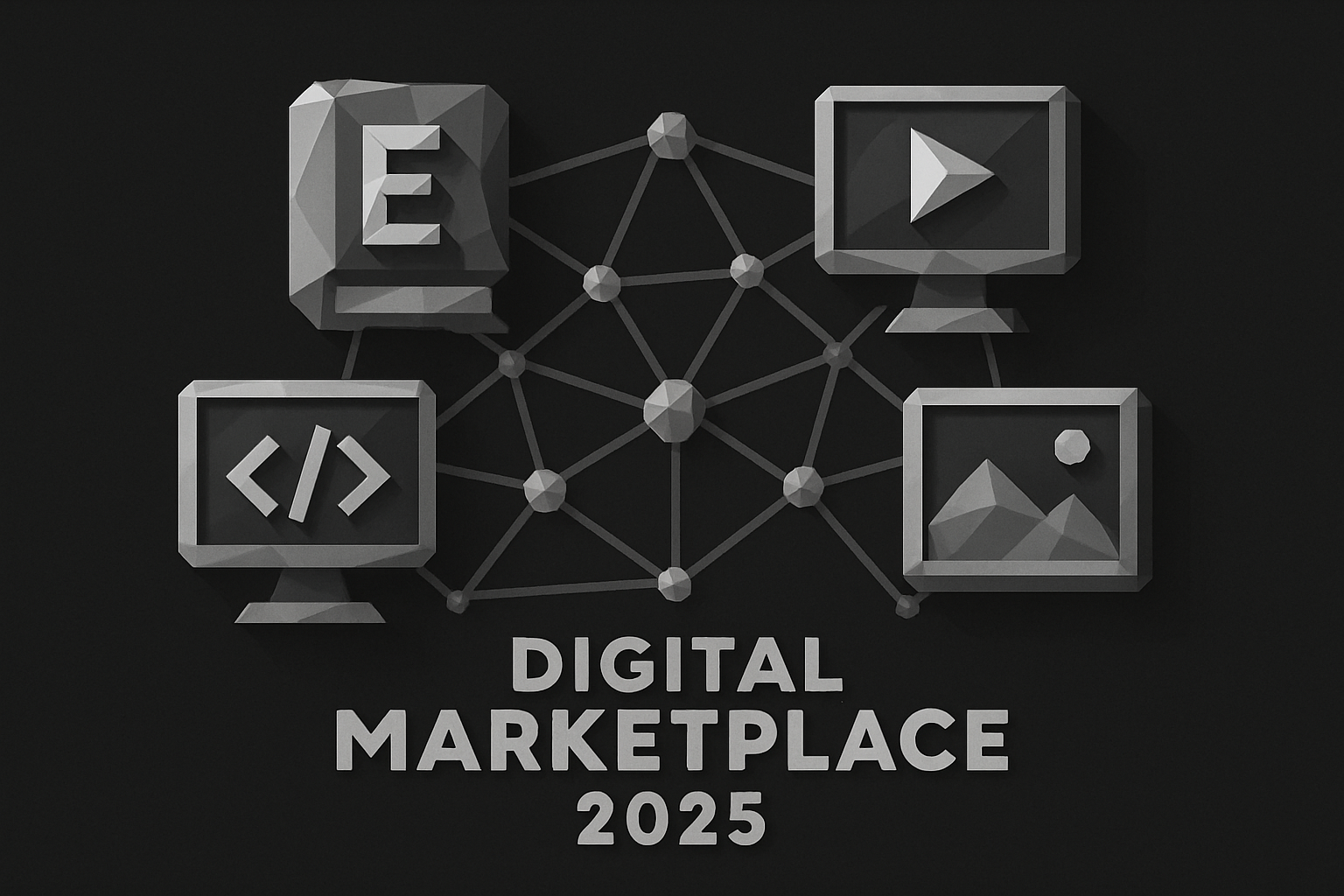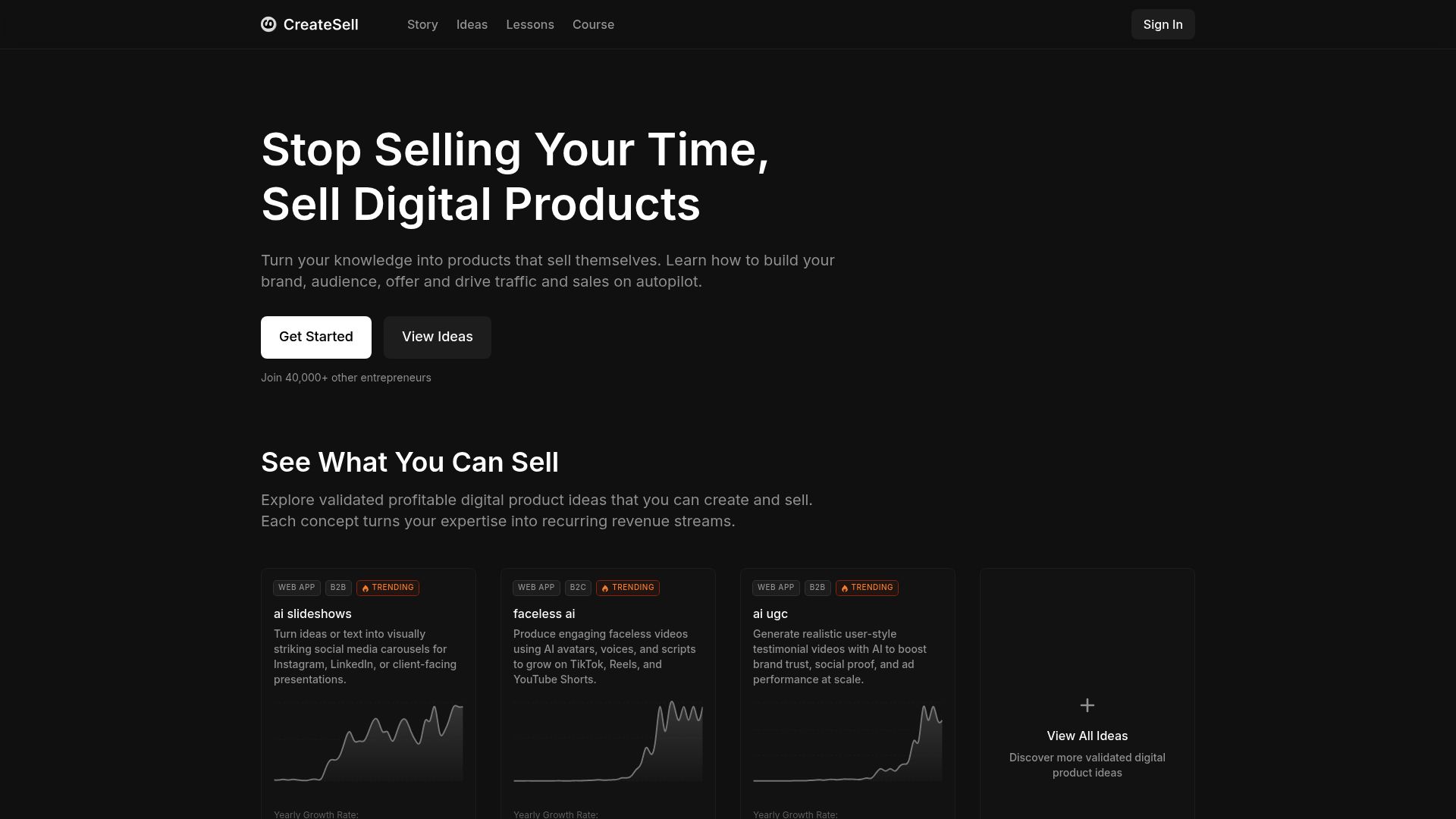Did you know the e-learning market alone is projected to surpass $400 billion by 2025? The explosive growth of digital product sales means there’s never been a better time to create and sell digital products.
As more people seek flexible income streams and global audiences, digital products offer unmatched scalability, recurring income, and time freedom.
This guide will empower you with step-by-step strategies—from idea generation and validation to marketing, automation, and scaling—so you can confidently launch your own digital product business.
Ready to unlock the potential of this booming market? Follow along to build a thriving digital product empire in 2025.
Understanding Digital Products in 2025
Digital products are redefining how entrepreneurs and creators reach audiences worldwide. In 2025, the ability to create and sell digital products is a game-changer for those looking to build scalable, flexible businesses online.

What Are Digital Products?
Digital products are intangible assets delivered and consumed entirely online. They are not bound by physical inventory or shipping constraints, making them easy to distribute and scale.
Common examples include:
- Ebooks and guides
- Online courses and masterclasses
- Design templates and digital downloads
- Software, plugins, and AI tools
- Digital art, music, and audio files
Unlike physical goods, digital products require no warehousing or shipping. This makes it simple to create and sell digital products to a global audience with minimal overhead.
Why Digital Products Are Booming
The surge in digital products is fueled by low startup costs and high profit margins. Sellers can reach customers worldwide, enabling sales around the clock.
Recent data shows the digital goods market is on a rapid upward trajectory. According to Digital Goods Market Growth Projections, this sector is expected to keep expanding through 2030, driven by demand for e-learning and SaaS. Trends like AI-powered solutions, personalization, and niche-focused offerings are reshaping how we create and sell digital products.
Entrepreneurs can now tap into new markets with innovative, tech-driven products that address real needs.
Types of Profitable Digital Products in 2025
The range of digital products you can offer in 2025 is broader than ever. Here are some of the most lucrative categories:
- Ebooks, guides, and workbooks
- Online courses, cohort programs, and masterclasses
- Software, mobile apps, and AI-driven plugins
- Templates, design assets, and downloadable resources
- Memberships, private communities, and premium content
- Audio products: podcasts, stock music, sound effects
If you want to create and sell digital products, consider mixing these formats for maximum value and recurring income.
Who Should Create Digital Products?
Anyone with expertise, creativity, or unique insights can create and sell digital products. This includes:
- Aspiring entrepreneurs and content creators
- Coaches, consultants, and educators
- Designers, developers, and marketers
For example, teachers are selling lesson plans, while designers offer templates for branding. Small business owners can use digital products to reach new markets and build authority.
The flexibility and scalability of digital products make them ideal for those seeking more freedom, passive income, and global impact.
Validating Your Digital Product Idea
Validating your digital product idea is a crucial step if you want to successfully create and sell digital products. Before investing time and resources, you need to ensure there’s real demand for your offer. Let’s break down the validation process into clear, actionable steps.
Generating Winning Ideas
Every successful journey to create and sell digital products starts with a strong idea. Begin by listing your skills, passions, and unique experiences. What do you know that others want to learn or use?
Research is next. Explore trending topics and emerging needs—think AI, remote work, or the creator economy. Tools like Google Trends, social media, or digital marketplaces can spark inspiration. For a curated list of what’s hot, check out the Digital products to sell in 2025 guide, where you’ll find top trends and profitable niches.
Don’t forget to keep a running list of ideas as you research. The best way to create and sell digital products is to align your expertise with real market demand.
Testing and Validating Demand
Once you’ve got a shortlist, it’s time to test before you create and sell digital products. Start by sharing your concept through landing pages or waitlists to gauge interest.
Use quick surveys, interviews, or polls to gather feedback. Analyze competitors—what are they missing? Data-driven tools like keyword research and online communities reveal the size and engagement of your potential audience.
If people are willing to pre-order or join a waitlist, that’s a clear sign your idea is worth pursuing. This approach ensures your time spent to create and sell digital products is invested wisely.
Avoiding Common Pitfalls
Many first-timers rush to build before validating, which can lead to wasted effort. Before you create and sell digital products, ask: Is there a real problem being solved?
Beware of saturated markets. If you see lots of similar offers, look for ways to stand out—unique features, better branding, or a niche focus.
Remember, validation is about proving there’s a willing audience. Skipping this step is one of the most common mistakes when you create and sell digital products.
How CreateSell Supports Idea Validation
CreateSell streamlines the process when you want to create and sell digital products. Their platform features a curated library of validated, trending ideas backed by real market data.

You’ll get access to growth rates, earning potential, and competitive analysis—making it easier to spot the best opportunities. Community feedback helps you refine your concepts, while step-by-step guidance walks you from idea to product validation.
With these tools, anyone can confidently create and sell digital products that stand out and meet genuine market needs.
Creating Your Digital Product: Step-by-Step Process
Ready to create and sell digital products in 2025? This process breaks down each step, making it easy to transform your expertise into a high-value digital asset. Whether you’re a first-timer or a seasoned creator, following a structured approach is key to delivering value and standing out in a crowded market.

Planning and Outlining Content
The foundation of any successful attempt to create and sell digital products is thoughtful planning. Start by defining your value proposition: What unique problem does your product solve? Identify your target audience and their pain points.
Map out clear learning objectives or deliverables. Use bullet points or mind maps to structure your ideas. This makes your content easier to develop and ensures each module or section delivers actionable value.
For a deeper look at this process, explore the Building digital products guide, which breaks down planning into actionable steps.
Producing High-Quality Digital Assets
Quality matters when you create and sell digital products. Choose the right tools for your format—Canva and Figma for design, Notion for templates, Teachable for courses, or code editors for software.
Keep your writing clear, visuals sharp, and code clean. Test your product on multiple devices to ensure accessibility and mobile-friendliness. Always aim for a polished, professional finish that reflects your brand and builds trust.
- Use templates for consistency
- Optimize images and files for fast downloads
- Include step-by-step instructions or walkthroughs
Crafting a Standout Brand and User Experience
A memorable brand helps you create and sell digital products that resonate with your audience. Develop a strong name, logo, and visual identity that aligns with your niche.
Design a clean, intuitive user interface. Guide users through onboarding, provide clear instructions, and make it easy for them to get help or leave feedback. Every interaction should reinforce your professionalism and commitment to customer success.
- Onboarding checklists
- Consistent color palettes
- Feedback forms and support channels
Setting Up Delivery and Access
Efficient delivery is essential when you create and sell digital products. Choose the right file formats—PDFs for guides, MP4 for videos, ZIP archives for design assets, or code repositories for software.
Decide between self-hosting or using platforms like Gumroad, Teachable, or Shopify. Automate delivery with instant download links or membership access. This ensures customers receive their products immediately, boosting satisfaction and reducing support requests.
- Instant email delivery
- Secure download links
- Easy onboarding instructions
Pricing Strategies for 2025
Pricing can make or break your ability to create and sell digital products profitably. Consider value-based pricing, where you charge based on the transformation your product delivers, rather than just competitor rates.
Experiment with freemium, tiered, or subscription models. Use psychological tactics such as charm pricing (ending in .99) or anchor pricing to highlight value. Regularly review your pricing based on customer feedback and analytics.
| Pricing Model | Best For | Example |
|---|---|---|
| Freemium | Apps, templates | Free + Pro |
| Tiered | Courses, memberships | Basic, Pro |
| Subscription | Content, communities | Monthly/Yearly |
Legal and Copyright Considerations
Protect your work as you create and sell digital products. Register your copyrights, set clear terms of use, and choose the appropriate licenses for your content.
Handle refunds and privacy policies transparently. Avoid using copyrighted material without permission, and always credit third-party assets. Establishing trust through legal compliance is crucial for long-term success.
- Copyright registration
- Refund and privacy policies
- Proper attribution and licensing
Leveraging AI and Automation in Product Creation
AI is revolutionizing how creators approach the task to create and sell digital products. Use AI tools for content generation, video editing, image creation, or even coding assistance.
Automate repetitive tasks like email sequences, customer support, and analytics. By integrating the latest tech trends, you can future-proof your products and free up time for innovation and growth.
- AI writing assistants
- Automated customer onboarding
- Real-time analytics dashboards
Building Your Audience and Marketing Your Digital Product
Building a loyal audience is the engine that powers your ability to create and sell digital products. With so many choices online, your marketing must be strategic, authentic, and data-driven. Let's break down the key pillars to help you reach, engage, and convert your ideal customers.

Audience Building Foundations
To create and sell digital products successfully, start by defining your ideal customer. Who are they? What problems do they face? Use organic channels like blogging, SEO, and social media to share valuable insights and build credibility.
Email newsletters are powerful for nurturing relationships. Consistency is key—show up regularly and engage with your audience in comments and direct messages. If you need proven strategies, check out this resource on building an engaged audience.
Remember, trust is your most valuable currency. Focus on solving real problems and offering genuine value.
Content Marketing and Thought Leadership
Content marketing is the backbone for those who want to create and sell digital products in 2025. Start with blogging, podcasting, or video content that addresses your audience’s pain points. Share actionable tips, industry trends, or personal stories to build authority.
Collaborate with others through guest posts, webinars, or partnerships. Repurpose your best content across platforms—turn a blog post into a LinkedIn article or a YouTube video.
Thought leadership requires consistency and authenticity. Over time, your expertise will attract followers eager to buy your digital products.
Paid Advertising and Influencer Marketing
Paid ads offer a fast track to visibility when you create and sell digital products. Platforms like Facebook, Instagram, and Google Ads let you target ideal customers based on interests and behaviors.
Experiment with small budgets and optimize your campaigns regularly. Collaborating with micro-influencers or niche creators can amplify your reach. Choose partners whose audience aligns with your product.
Track your ROI with analytics tools. The right mix of paid ads and influencer marketing can drive traffic, build credibility, and boost sales quickly.
Email Marketing and Sales Funnels
Email marketing is essential for those looking to create and sell digital products. Start with a compelling lead magnet, such as a free guide, checklist, or mini-course, to grow your list.
Nurture your subscribers with automated email sequences that educate, build trust, and highlight your offers. Use segmentation to send personalized messages for higher conversion rates.
Build a streamlined sales funnel: attract leads, nurture relationships, and guide them to purchase. Automation saves time and ensures every subscriber gets a tailored experience.
Social Proof and Community Building
Social proof builds confidence in your ability to create and sell digital products. Collect testimonials, reviews, and case studies from satisfied customers. Display these on your website and product pages.
Launch a community space, such as a Discord server or Facebook Group, to foster engagement. Encourage members to share their experiences, ask questions, and help each other.
Gamification—like badges or challenges—can boost participation. An active community not only supports your customers but also attracts new buyers.
SEO for Digital Products
SEO ensures your digital products are discoverable by those searching for solutions. Start with keyword research to find what your audience is searching for when they want to create and sell digital products.
Optimize your website with relevant keywords, meta descriptions, and fast-loading pages. Don’t forget marketplaces and directories—these can drive additional visibility.
Technical SEO, such as structured data and mobile optimization, is crucial in 2025. Regularly update your content to stay relevant and maintain rankings.
Launch Strategies for Maximum Impact
A successful launch can set the tone for your ability to create and sell digital products long-term. Build anticipation with waitlists, teasers, and beta access for early adopters.
On launch day, consider live events, webinars, or limited-time offers to drive urgency. Use feedback from your first customers to iterate and improve your product.
Post-launch, keep the momentum going. Gather testimonials, release updates, and plan for your next big idea. A well-executed launch creates buzz and builds lasting demand.
Choosing the Right Platforms and Tools
Selecting the right platforms and tools is crucial when you want to create and sell digital products efficiently in 2025. With so many options available, your choices impact everything from your reach to your profit margins. Let’s explore the top marketplaces, self-hosting, must-have tools, and seamless delivery solutions to set your digital product business up for success.
Top Digital Product Marketplaces in 2025
The landscape for selling digital goods has never been more vibrant. Leading platforms like Gumroad, Podia, Teachable, Shopify, and Etsy enable creators to reach global audiences with ease. Each marketplace offers unique features: Gumroad and Podia support instant downloads, while Teachable specializes in online courses.
Fees and audience reach vary, so compare options before you create and sell digital products. For an in-depth look at platform features and tips, check out this Best websites to sell digital products guide.
| Platform | Best For | Key Features |
|---|---|---|
| Gumroad | Ebooks, courses | Instant payouts |
| Teachable | Courses | Drip content |
| Etsy | Design assets | Large audience |
Building Your Own Website vs. Using Marketplaces
Should you build your own site or use marketplaces? Hosting your own website gives you full control over branding, data, and scalability. You can customize checkout experiences and integrate advanced marketing tools.
However, technical setup—like hosting, payment gateways, and security—requires more effort. Many creators blend both approaches: they create and sell digital products on marketplaces for exposure, then use their own website to nurture loyal customers and maximize revenue.
Consider your tech skills, goals, and desired level of independence when choosing your path.
Essential Tools for Creation and Sales
To create and sell digital products efficiently, you’ll need a solid toolkit. For design, Canva and Figma offer intuitive interfaces for graphics and templates. If you’re building courses, Teachable, Thinkific, and Kajabi streamline content delivery.
Automation tools like Zapier or ConvertKit handle repetitive marketing tasks. Analytics platforms reveal customer behavior and optimize sales. Don’t overlook reliable file hosting and backup solutions to safeguard your creations.
Organize your workflow so each tool supports your business goals and enhances your customer experience.
Integrating Payments, Delivery, and Customer Support
Smooth payment processing is essential when you create and sell digital products. Popular processors include Stripe, PayPal, and Apple Pay, each offering secure, global transactions.
Automated delivery—via email, membership sites, or download links—ensures customers access their purchases instantly. For customer support, tools like Help Scout and Zendesk streamline queries and refunds.
Efficient integration of these elements not only boosts customer satisfaction but also saves you time, letting you focus on creating and scaling your digital products.
Automating and Scaling Your Digital Product Business
Automation is the secret engine behind every successful effort to create and sell digital products. By strategically leveraging technology, business owners can focus on growth instead of getting bogged down by repetitive tasks. Let’s explore how to streamline your operations, build a scalable system, and unlock long-term success.
Automating Sales and Marketing
To efficiently create and sell digital products, automation is a must. Set up evergreen sales funnels and automated email sequences to nurture leads and convert them into customers on autopilot. Chatbots and AI-powered support tools keep customers engaged without requiring your constant attention.
The rapid rise of artificial intelligence is transforming business workflows. From automated content generation to predictive analytics, AI integration in business by 2025 is making automation more accessible and powerful than ever. This allows you to scale your reach, optimize marketing, and build passive income streams that grow while you sleep.
Outsourcing and Delegating Tasks
As you create and sell digital products, your to-do list will grow. Outsourcing is your ticket to maintaining focus and momentum. Hire freelancers for design, copywriting, or tech support, and bring in virtual assistants for daily operations.
Essential tools for managing your remote team include:
- Project management software (e.g., Trello, Asana)
- Communication platforms (e.g., Slack, Zoom)
- Collaboration tools (e.g., Google Workspace)
Delegating tasks allows you to work on your business instead of in it, freeing up time to innovate and expand your digital product catalog.
Tracking Metrics and Optimizing Performance
To successfully create and sell digital products at scale, you must track performance and optimize constantly. Monitor key performance indicators (KPIs) such as sales, conversions, and customer retention to identify what’s working and what needs improvement.
| Metric | Why It Matters |
|---|---|
| Sales Volume | Revenue growth |
| Conversion Rate | Funnel efficiency |
| Customer Retention | Long-term profit |
Use analytics tools, A/B testing, and feedback loops to fine-tune your offers. This data-driven approach ensures your digital product business remains agile and profitable.
Scaling Up: Expanding Your Digital Product Empire
Once your systems are running smoothly, it’s time to scale your efforts to create and sell digital products. Develop product suites and upsells to increase customer lifetime value. Launch affiliate and referral programs to tap into new audiences with minimal effort.
Consider expanding into international markets or localizing your offerings for greater reach. By continuously evolving your business model and leveraging your automated foundation, you set the stage for exponential growth and long-term sustainability.
Future Trends and Opportunities in Digital Products
The future for those who create and sell digital products is brighter than ever. As technology evolves and consumer habits shift, new trends and opportunities emerge, offering creators fresh ways to innovate and grow. Staying ahead of these changes is crucial for sustained success in 2025 and beyond.
Emerging Trends for 2025 and Beyond
AI-driven personalization is transforming how creators connect with customers. Digital products now adapt to individual learning styles, interests, and behaviors, making experiences more engaging and effective. According to Content Personalization Trends, AI-powered content is reshaping user engagement and retention across platforms.
Interactive and gamified digital products are on the rise, making learning and consumption more enjoyable. Micro-learning—delivering content in bite-sized pieces—caters to busy lifestyles and boosts completion rates. To thrive, creators must adapt to these trends as they create and sell digital products in 2025.
New Opportunities in Niche Markets
Niche markets are exploding with potential for those who create and sell digital products. By focusing on underserved communities or specialized interests, creators can build loyal audiences and face less competition. Global trends like sustainability, wellness, and remote work are fueling demand for unique solutions.
Recent E-commerce Growth Statistics 2025 highlight the surge in digital sales and the dominance of mobile-first experiences. Successful niches include eco-friendly templates, remote team toolkits, and wellness-focused online courses. Spotting fresh gaps and moving quickly is key to capturing these opportunities.
Preparing for the Next Wave of Digital Entrepreneurship
To succeed as you create and sell digital products, continuous learning is essential. Markets and technology shift fast, so staying agile and upskilling regularly keeps your business resilient. Embrace new tools, test ideas, and stay close to your audience’s needs.
Building a future-proof business means being ready to pivot, experiment, and innovate. Foster a mindset of adaptability, and you’ll be well-positioned to ride the next wave of digital entrepreneurship, achieving lasting impact and income.
Ready to turn your expertise into a digital product that works for you—day and night? We’ve just covered everything from idea validation and branding to launching and scaling, so you have a clear path ahead. Whether you’re a creator, coach, or entrepreneur, there’s never been a better time to make the leap and claim your piece of this booming market. If you’re excited to start building your own self-sustaining digital product business, let’s take the next step together—Get Started and unlock the support, insights, and tools you need to succeed.